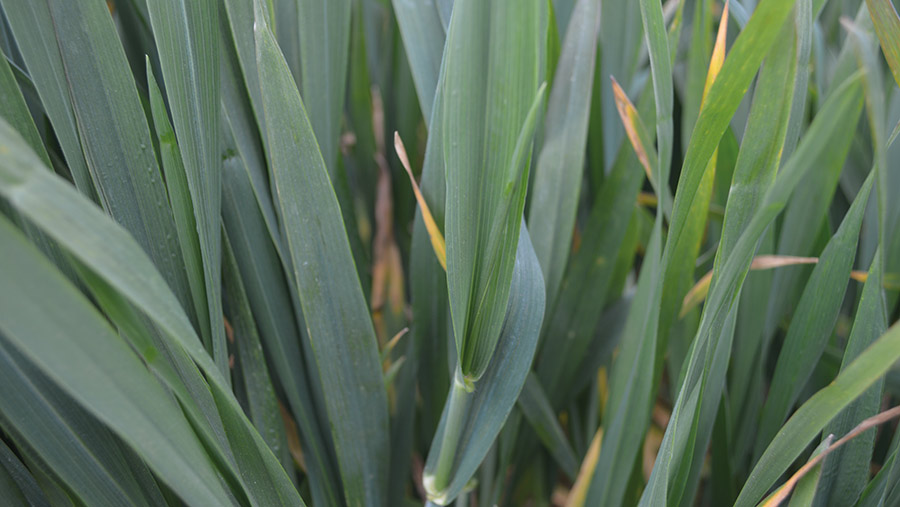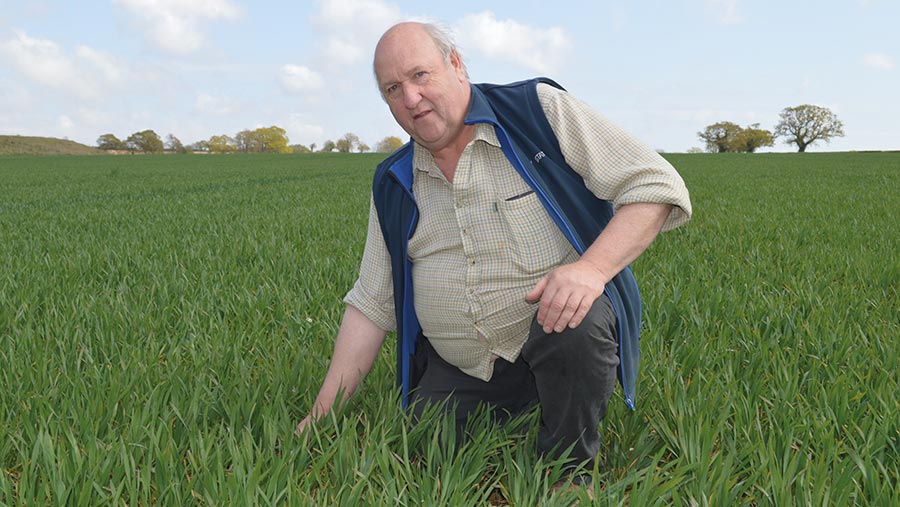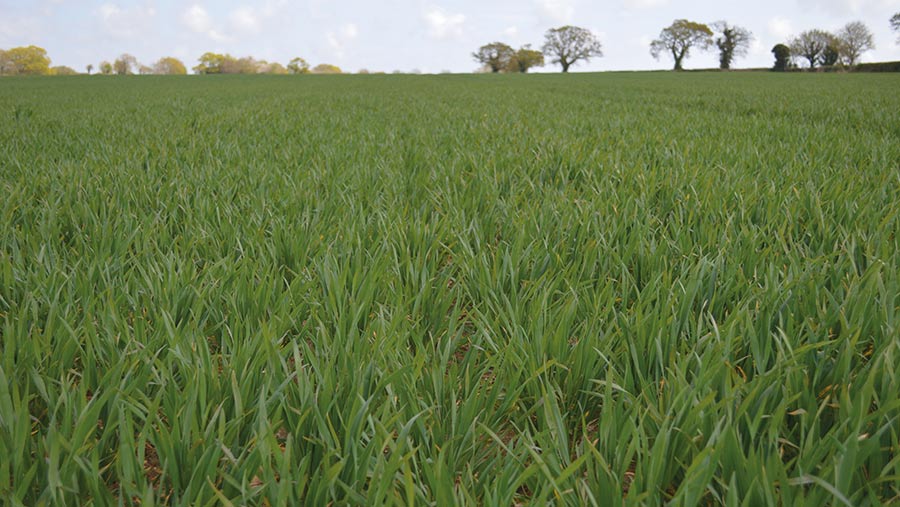Wheat grower plans fewer sprays to delay disease resistance
 © MAG/David Jones
© MAG/David Jones Mike Wilton is planning fewer fungicide sprays on his winter wheat this season, although by using the latest chemistry he is aiming for good clean crops and to avoid disease resistance building up.
The north Norfolk farm manager has dispensed with an early season T0 spray this spring and is focusing on robust T1 and T2 applications.
He sees the T3 ear spray as an option for the 400ha of feed wheat he is growing on his light sandy soils.
By cutting the frequency of fungicide spray applications, he is looking to reduce the risk of resistance to disease building up.
By basing his spray programme on the very latest fungicide products he is looking to achieve the most effective disease control.
“I am using fewer fungicide applications, but the ones I am using are more robust against diseases and are better able to cope with the risk of resistance building up,” he tells Farmers Weekly.
See also: Two new fungicides to fight septoria in wheat grower’s plans
Farm facts: Stody Estate, Melton Constable, Holt, Norfolk
- Farming 1,680ha, plus contract farming arrangements
- Light sandy loam soils over gravel
- Twelve-year rotation – potatoes, winter wheat, sugar beet, spring barley, oilseed rape, winter wheat, carrots/onions, winter wheat, sugar beet, spring barley, oilseed rape, winter wheat
- Land is let out for vegetable production and for outdoor pigs. In the heart of the estate are the River Glaven water meadows which are grazed by Aberdeen Angus cattle and sheep under an old Higher Level Stewardship environmental scheme.
Clean-up spray
After extensive on-farm trials, he is basing his “clean-up” T1 wheat spray, usually applied towards the end of April, on Revystar or Ascra this season, and the flag leaf T2 treatment in late May on Univoq.
Revystar is in its second full season of use and contains a new azole, mefentrifluconazole, with an existing SDHI, fluxapyroxad.
Univoq is in its first full season of availability and contains a new site of action picolinamide called fenpicoxamid and an existing azole, prothioconazole.
The slightly older Ascra contains two SDHIs – bixafen and fluopyram – and the azole prothioconazole.

Mike Wilton © MAG/David Jones
The sharp rise in fertiliser prices and other input costs, such as agrochemicals, has forced him into a business review this season to manage costs and, especially, cashflow while still looking to maximise wheat yields.
For the 1,680ha Stody Estate, just south of Holt in north Norfolk, that mean scrutinising all costs.
This especially means fertiliser and fungicides and coming up with the appropriate level of inputs on the estate where five-year average wheat yields are 9.25t/ha and only first wheats are grown.
His first two defences against disease are varietal choice and drilling date.
For the first he is moving towards more disease-resistant wheat varieties such as Dawsum and Extase, while Gleam, Skyscraper and Insitor are also grown and about 40% of the crop is grown for seed.
Light-land wheat
Traditionally, wheat drilling started on 1 September on his light blackgrass-free soils as building up biomass is important on such light soils.
The banning of neonicotinoid seed dressings in December 2018, used to control aphid-borne barley yellow dwarf virus, changed all that, and drilling was pushed back to start on 15 September.
The key now is to make sure wheat drilling is finished by end-October.
This season’s T0 sprays have disappeared, and would have been used only if yellow rust was an issue.
The crops still get treated at the T0 stage, but this is with a plant growth regulator and a biostimulant rather than a fungicide.
Although yellow rust is seen on the estate, septoria is the main driver of his fungicide programmes.
He sees T1, when leaf three is fully emerged, as the most important building block of a successful fungicide strategy.
“The opportunity to save money at T1 is very limited, and if you do save money, you are likely to have to spend it later,” he says.
This season he is using either 1 litre/ha of Revystar or 1 litre/ha of Ascra at T1, below the maximum recommended doses for both at 1.5 litres/ha.
If rusts are a serious problem he will add in the strobilurin pyraclostrobin.
“Most fungicide products act protectively, so the aim is to keep the crops clean, and if we are successful in that, then there is the opportunity to tweak rates at T2,” he says.
Flag leaf spray
Mr Wilton is intending to use Univoq, which is recommended at 2 litres/ha at the T2 stage, when the flag leaf is fully emerged, due to its persistency and as it introduces a new site of action active ingredient.
It is hoped this will mop up infections not controlled by an SDHI and azole at T1.
“Univoq and Revystar are very good products and I don’t believe it is a choice between the two: both should be used in a programme,” he says.
He is very aware that rain is needed during June for grain filling on his light free-draining soils, but that can also brings in the wet-loving septoria, as happened in the summer of 2021, and so the persistency of Univoq will be useful at T2.
For his T3 ear spray approach, he will be watching the weather and – depending on the risk – he will either omit the spray or use a product relative to the risk.
This could range from the relatively inexpensive tebuconazole to a more pricey tebuconazole/prothioconazole mix or, at the top end, an SDHI if the septoria threat is high, while the SDHI of choice could be Elatus if the rust risk is high.

© MAG/David Jones
He says the new chemistry of Univoq and Revystar will be more expensive to use, while overall fungicide prices are rising 10-15% this season.
But by cutting out the T0 and keeping T3 as an option, he is hoping to keep his wheat fungicide seasonal spend unchanged at about £100-£120/ha.
Future fungicide strategy will also depend on nitrogen rates, and next year on his feed wheat rates are set to come down from 220kg/ha currently to 180-200kg/ha if fertiliser prices stay at current high levels.
Nitrogen use
The estate is likely to use more splits of nitrogen in a little and often approach to make the best use of this valuable nutrient.
The overall lower nitrogen rates will probably reduce the disease pressure in the wheat and so fungicide use in the future will be tailored appropriately.
“The availability of nitrogen is a factor in fungicide use, but the weather will still have a bigger impact on fungicide use,” he says.
The key to good yields on such light soils is to maximise root mass and hence plant biomass, and the best way to do this is to drill early.
This may also help the plant take up and store more available nitrogen in the soil in the autumn, so improving nitrogen efficiency.
With the current high price of wheat he is looking at opportunities to improve his soils using cover crops ahead of spring crops, such as sugar beet and vegetables.
He is experimenting with strip tillage as he believes direct drilling is not appropriate for his soils which can easily slump.
“Increasing the soil organic matter is important, but good biology in the soil is even more important,” he says.
Fungicide actives
- Univoq Picolinamide fenpicoxamid (Inatreq) + azole prothioconazole
- Revystar SDHI fluxapyroxad + azole mefentrifluconazole (Revysol)
- Elatus SDHI benzovindiflupyr (Solatenol) + azole prothioconazole
- Ascra SDHIs bixafen and fluopyram + azole prothioconazole
- Comet Pyraclostrobin

